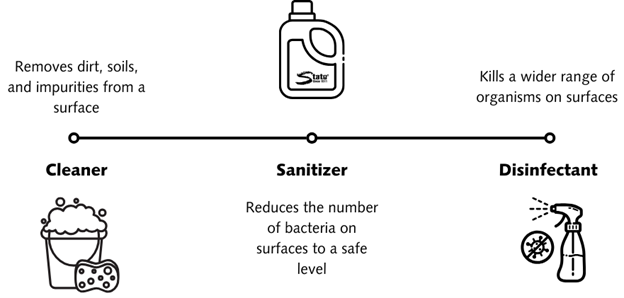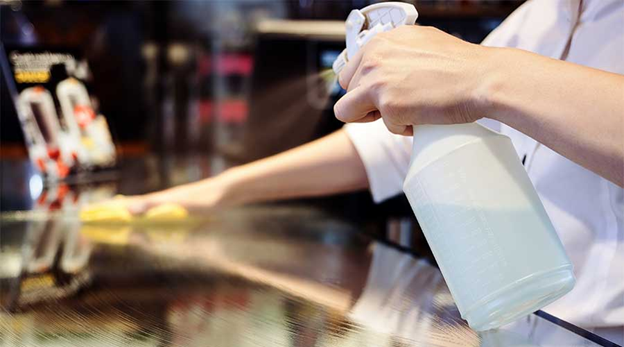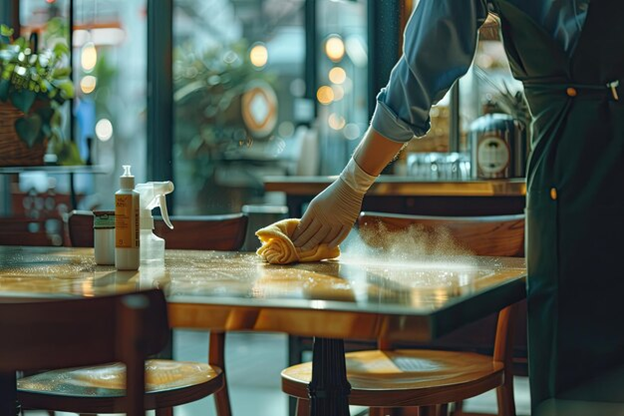Dish Machine Sanitizer vs. Disinfectant
Dish Machine Sanitizer vs. Disinfectant
When you think about how to kill germs, your mind probably goes to a sanitizer or a disinfectant. This same principle probably applies to how you think about your commercial dish machine. But what is a sanitizer, and what is a disinfectant? Are the two interchangeable or do they differ? When should they be used?
At State Cleaning Solutions, we lease and service commercial dishwashers and other kitchen equipment, as well as provide chemical products for these systems. When you need a cleaning solution, you want to know that it’ll work the way you need it to, but this can be challenging when you don’t always know what the different terms mean.
To help you understand what product you need, we will explain what a sanitizer is, what a disinfectant is, when to use each, and how this difference impacts you. After reading, you’ll know what option to look for.
What is Commercial Sanitizer?
Sanitizer is used to reduce the number of pathogens on a surface. In the case of commercial dishwashers, this would mean reducing germs on dishware through either heat or chemical sanitization.
Reducing pathogens does not mean fully eliminating them but rather bringing their number down to a safe level. However, sanitizers also do more than simply clean surfaces. Yes, cleaners remove dirt, soils, and impurities from a surface, but sanitizers reduce the number of bacteria on surfaces to a safe level, and disinfectants kill a wider range of organisms on surfaces.
Additionally, unlike disinfectants, sanitizers do not require a potable water wash in order to be food safe.
What is Commercial Disinfectant?
On the other hand, disinfectants are used to eliminate pathogens from surfaces and are not used in commercial dishwashers. Disinfectants are more powerful than sanitizers with stronger concentrations of chemicals.
For example, a disinfectant might use concentrated bleach to kill most of the germs on a surface. You probably wouldn’t want this coming into contact with your dishware, but a more diluted version would be considered a sanitizer and it would be less harsh on your dishware. The intensity of these chemicals is a spectrum, and disinfectants are at the strongest end. This is great for situations where you need to ensure germ elimination, but it can be overly harsh in scenarios like basic dishwashing.
Additionally, in order to be considered food safe, disinfectants require the use of a potable water rinse.
When Should Commercial Sanitizer and Disinfectant Be Used?
Now that you know the difference between sanitizer and disinfectant, it’s important to understand when each should be practically used.
For general cleaning needs, sanitizer is helpful. Maybe you need to clean dishes, countertops, or toys. All these items will benefit from a general cleaning and sanitization to reduce pathogens. Because these items are used without typically coming into high contact with bacteria, they should be fine after basic sanitization. In other words, low-to-medium contact areas will benefit from sanitization. Additionally, sanitizers usually do not require a potable water rinse to be food safe.
Meanwhile, for areas of higher concern, disinfectant is a better option. For example, let’s say that you need to clean toilets, doorknobs, or sinks. In any of these or other high-contact locations, there’s more potential for viruses, so you’ll need a stronger solution.
It’s just important to ensure that your intended application area isn’t susceptible to damage by disinfectants (e.g., rubber and plastic may be damaged by some disinfectants. Read the label for any surface safety statements). Also, if using disinfectants on food contact surfaces like prep tables or tables in the dining room, a potable water wash is required.
How Does This Affect Your Facility?
Knowing the difference between sanitizer and disinfectant will (and should) impact your approach toward your facility’s hygiene. Understanding the difference will help you to realize how your cleaning products are actually working for you, but it also helps guide you to buy the correct products.
Let’s say that you use sanitizer for all areas of your facility, from your countertops to your bathroom floors. Now that you know that high-touch areas benefit more greatly from disinfection, you might want to invest in disinfectant for these areas, helping to reduce cross-contamination in your facility.
Similarly, maybe you’ve been using disinfectant for areas that don’t need it—like tabletops. Now that you know this area doesn’t need such harsh chemicals, you can use a milder product, keep your facility safer, and possibly save money.
The difference between sanitizer and disinfectant may seem minor, but it can make a big difference in the cleanliness and safety of your facility. Ensure that you’re using the correct products for the correct purposes for the best results.
Learn About Chemical Sanitization Versus Heat Sanitization
Sanitizer and disinfectant are often synonymous in our minds, but it’s not always clear when one should actually be used over the other. Now that you know the difference between the two and when they should be used, continue learning about sanitization in dish machines by reading about chemical sanitization versus heat sanitization.













